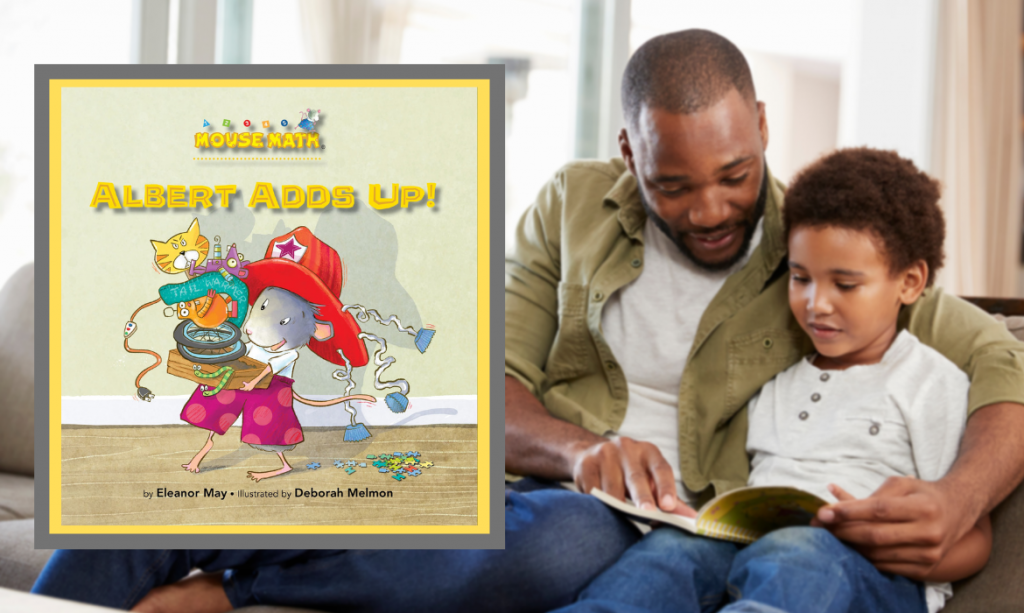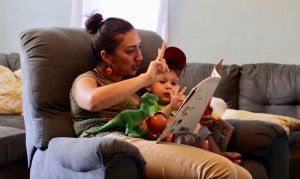The first criterion for any math storybook is that it be fun to read—interesting, captivating, and engaging. “Albert Adds Up!,” written by Eleanor May and illustrated by Deborah Melman, is a splendid example of a “Story Math-Book”—a book that is first and foremost a good story, and second, a book that involves basic math ideas and procedures.
What’s the Story?
Albert, a young mouse, covets a book that his sister, Wanda, has just brought home from the library. To get Captain Slime, Albert offers a series of trades, beginning with one Robo-Rat along with a Mechano-Mole, and then, to sweeten the (Slime) pot, goes on to offer a giant gumball (previously chewed), a tail warmer, two tricycle wheels, two worms, and other valuables.
Yet even after offering 11 items, Albert is distressed to learn that Wanda wants none of them, rejecting each trade in turn. Poor Albert!
But the author does not leave him empty-pawed. The story ends with surprising plot twists that will delight the young (and older) reader. (Adults, see if you can find the famous painting of the Mona Mous-A.)

What’s the Math?
The title cites addition (although subtraction is central as well) and the book contains written math symbolism at the bottom of some of the pages. The story is mathematical in three vital senses—the everyday math, the math talk, and the symbols.
Everyday math First, the plot involves Albert’s frantic offering of more and more trades to reach his elusive goal (Captain Slime), and then Wanda’s devastating rejection of his efforts. Albert begins with one object and then escalates all the way up to 11, mostly adding one at a time, but sometimes adding two.
Later, he has to subtract as Wanda rejects* his trades. What Albert giveth (addeth), Wanda taketh away (subtracteth). In the end, he learns that subtraction can negate addition, a central mathematical idea. Albert and Wanda are engaged in informal, everyday math, which can be more meaningful than the dry number facts and written material children often learn in school.
Math talk Second, the story involves considerable everyday math talk, as in the first illustration, where Albert says: “You can have them both. Plus all three toys. That’s five things altogether.” So many math words in three short sentences: both, plus, all, three, five, altogether. Further, the three sentences in which the words are embedded describe a mathematical operation, addition.
Shared verbal communication is a key feature of understanding and doing math. (Unfortunately, it is the male Albert who always talks about the math and solves the problems. Why is female Wanda silent on these matters? Cat got her tongue?)
Written symbols Third, what about the story’s written symbols? Are they appropriate for the 4- or 5-year-olds reading the book? I think the answer is yes, because the symbols are not presented in isolation, but instead are introduced in a meaningful sequence.

The overall strategy is first to show the action and the talk in the top, largest page section; then to put below it a box giving a schematic visual summary of the action; and below that to show the number sentence. Links going from top to bottom—from everyday math story action to schematic summary to equation—provide an effective strategy for teaching children the meaning of the number sentence.
At the same time, this method is not magic: young children will not at first easily understand the written symbols. But remember that children like to read (some) books over and over. You can help by discussing the number sentences—if and only if the children are interested and ready for the discussion!—during the repeated readings. If the children still do not understand or are not interested in understanding, no worries. The book is fun to read; it conveys the informal math very clearly; and the written math can wait.
So “Albert Adds Up!” is a “Story Math-Book,” because the necessary charming story is about basic math ideas and even introduces math symbolism in a meaningful way.
* Could the book be called, “Albert Adds Up and Wanda Adds Down”? The answer may be yes. To understand why, entertain negative thoughts.
Go to the DREME Storybook Guide Based on Eleanor May’s “Albert Adds Up!” Also available in Spanish.
Albert Adds Up, (2014), written by Eleanor May and illustrated by Deborah Melman, New York: The Kane Press.
Albert Adds Up is part of the Mouse Math series that covers other topics like counting and doubling.



